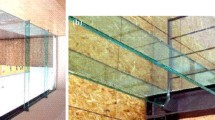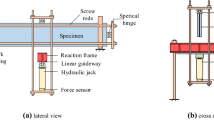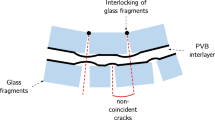Abstract
The stability of monolithic glass fins is reasonably well defined; as an elastic material it behaves in a similar manner to other elastic materials such as steel, for which there are many equations of different forms which give similar results. Special care is required for continuous restraint to the tension flange. Equations presented in Australian Standard AS1288 Glass in Buildings—Selection and Installation (2006) have been used successfully for many years for monolithic fins when used with the strength model of AS1288, but require a more comprehensive approach when using laminated fins and/or strength models that allow higher levels of stress. This paper presents strategies for determining the moment capacity of beams made of laminated glass with continuous flexible buckling restraints, such as structural silicone, which have initial imperfections and a known design strength capacity. The accuracy and validity of the approach is also assessed by means of comparisons with the outcomes of Finite Element numerical analyses.










Similar content being viewed by others
Notes
Note for systems with multiple half-wavelengths, use the distance between points of contraflexure as “L”. For not-restrained laminated glass fins subjected to lateral-torsional buckling, the effective bending inertia \({I}_{{y}_{eff}}\) may be evaluated by using coefficient ψ = π2⁄a2, where a is the half wave-length, as per Table 2. As ψ will affect the effective thickness and may change nR, the solution may be iterative.
This section for effective torsional stiffness is included for stability calculations. For applied torsional loads, use of finite element method or similar is recommended to capture longitudinal stresses due to warping of each ply, which are not calculated in this method.
References
Australian Standard AS1288: Glass in Buildings—Selection and Installation, Standards Australia GPO Box 476 Sydney, NSW, Australia (2006)
ANSI/AISC 360 Specification for Structural Steel Buildings. American Institute of Steel Construction
ASTM E1300–- Standard Practice for Determining Load Resistance of Glass in Buildings, ASTM International. West Conshohocken, PA
Bedon, C.: Lateral-torsional buckling (LTB) method for the design of glass fins with continuous lateral restraints at the tensioned edge. Compos. Struct. 266, 113790 (2021)
Bedon, C., Belis, J., Amadio, C.: Structural assessment and lateral-torsional buckling design of glass beams restrained by continuous sealant joints. Eng. Struct. 102(11), 214–229 (2015)
CEN/TS 19100–1 Design of glass structures–- Part 1: Basis of design and materials
D’Ambrosio, G., Galuppi, L.: Enhanced effective thickness model for buckling of LG beams with different boundary conditions. Glass Struct. Eng. 5(2), 205–210 (2020)
EN 1993-1-1: Eurocode 3: Design of steel structures–- Part 1–1: General rules and rules for buildings
EN 16612: Glass in building. Determination of the lateral load resistance of glass panes by calculation
Foraboschi, P.: Buckling of a laminated glass column under test. Struct Eng 87(1), 2–8 (2009)
Galuppi, L., Royer-Carfagni, G.: Enhanced effective thickness of multi-layered laminated glass. Compos. Part B 64, 202–213 (2014)
Galuppi, L., Royer-Carfagni, G.: Enhanced effective thickness for laminated glass beams and plates under torsion. Eng. Struct. 206, 110077 (2020)
Galuppi, L., Manara, G., Royer-Carfagni, G.: Practical expressions for the design of laminated glass. Compos. Part B 45, 1677–1688 (2013)
Kala, Z.: Elastic lateral-torsional buckling of simply supported hot-rolled steel i-beams with random imperfections. Procedia Eng. 57, 504–514 (2013)
NCCI SN-003-EN-EU: NCCI: elastic critical moment for lateral torsional buckling, by Access Steel. https://eurocodes.jrc.ec.europa.eu/doc/WS2008/SN003a-EN-EU.pdf
Nizich, A.J., La Greca, A.M., Galuppi, L.: Advances in Effective Thickness For Laminated Glass Structural Design, Facade Tectonics Institute's biennial World Congress (2022)
Santo, D., Mattei, S., Bedon, C.: Elastic critical moment for the lateral-torsional buckling (LTB) analysis of structural glass beams with discrete mechanical lateral restraints. Materials 13(11), 2492 (2020)
Simulia.: ABAQUS computer software, v.6.14, Providence, RI, USA (2022)
Strand7 finite element software, R3.1.1, Sydney, NSW, Australia. https://www.strand7.com/
Funding
No funding was received to assist with the preparation of this manuscript.
Author information
Authors and Affiliations
Corresponding author
Ethics declarations
Conflict of interest
On behalf of all authors, the corresponding author states that there is no conflict of interest.
Additional information
Publisher's Note
Springer Nature remains neutral with regard to jurisdictional claims in published maps and institutional affiliations.
Rights and permissions
Springer Nature or its licensor (e.g. a society or other partner) holds exclusive rights to this article under a publishing agreement with the author(s) or other rightsholder(s); author self-archiving of the accepted manuscript version of this article is solely governed by the terms of such publishing agreement and applicable law.
About this article
Cite this article
Green, R., Bedon, C. & Galuppi, L. Design and stability of laminated glass fins with continuous lateral silicone restraint. Glass Struct Eng 8, 363–382 (2023). https://doi.org/10.1007/s40940-023-00224-1
Received:
Accepted:
Published:
Issue Date:
DOI: https://doi.org/10.1007/s40940-023-00224-1




